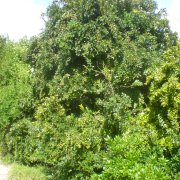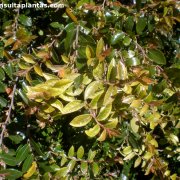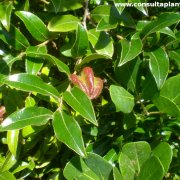Care of the tree Diospyros whyteana or Bladder-nut |
|
The genus Diospyros, family Ebenaceae, includes about 700 species of trees native to tropical regions on all continents. Some species are: Diospyros whyteana, Diospyros kaki, Diospyros decandra, Diospyros nigra, Diospyros australis, Diospyros malabarica, Diospyros texana, Diospyros virginiana. Common names: Bladder-nut, Blackbark, Swartbas, Wild coffee. This species is native to South Africa, Malawi, Mozambique, Swaziland, Tanzania, Zambia, and Zimbabwe. They are evergreen dioecious trees with a pyramidal or rounded crown and slow growth that reach 8 meters (26.24 feet) in height. The leathery leaves with hairy margins are bright green above and light green below. The scented flowers are white or cream in color and are bell-shaped. They bloom in spring. The reddish fruits are quite decorative. Bladder-nut is used as isolated specimens, to form hedges, in large pots for patios and terraces and as bonsai. Diospyros whyteana grows in full sun and light shade exposures in temperate climates. It resists light and occasional frosts. The soil can be normal, well-drained garden soil with coarse sand that contains some organic matter. Transplanting is done in early spring. Water regularly waiting for the substrate to almost dry completely. It's drought resistant when well established. Fertilize with manure or compost at the end of winter and with mineral fertilizer at the beginning of spring. Prune lightly in autumn to maintain a compact habit or if grown as a hedge. Wild coffee is a plant resistant to the usual pests and diseases but sensitive to excess moisture in the roots. Propagate from seed sown in spring (scarify before sowing); germinate in 5-8 weeks. |
Images of the tree Diospyros whyteana or Bladder-nut |
Find plants
Diospyros whyteana or Bladder-nut | Care and Growing
© 2026 FavThemes




